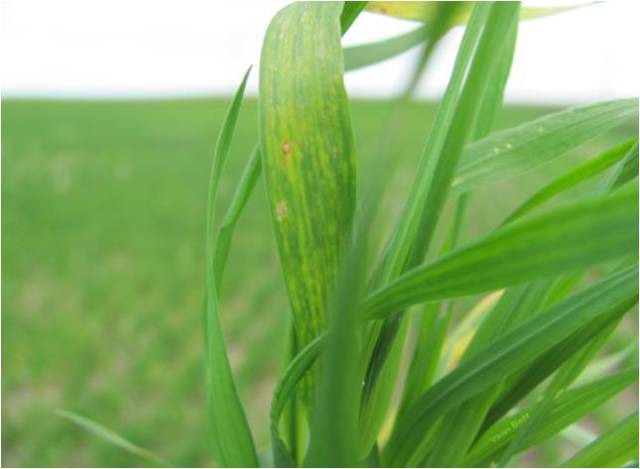Manitoba Insect and Disease Update: May 13, 2014
Compiled by:
- John Gavloski, Entomologist
Manitoba Agriculture, Food and Rural Development
Phone: (204) 745-5668
Fax: (204) 745-5690. - Vikram Bisht, Plant Pathologist
Manitoba Agriculture, Food and Rural Development
Phone: (204) 745-0260
Fax: (204) 745-5690
To report observations on insects or plant pathogens that may be of interest or importance to farmers and agronomists in Manitoba, please send messages to the above contact address.
To be placed on an E-mail list so you will be notified immediately when new Manitoba Insect and Disease Updates are posted, please contact John Gavloski at the address or numbers listed above.
Summary: Because of the late seeding and crop emergence, there has been little crop damage due to insects or plant pathogens. A few early-season things to watch out for though are wheat steak mosaic virus, cutworms and wireworms. If any higher populations of cutworms and wireworms are found, there are entomologists looking for samples to help us know what our more common wireworm species are, and what are the key natural enemies of our cutworms.
Wireworm Survey: There are many species of wireworms, and the methods and insecticides we use to manage wireworms are not equally effective on all species. Thus, knowing regionally what the dominate species of wireworms are can be important. Dr. Bob Vernon, with Agriculture and Agri-Food Canada in Agassiz, B.C. is once again collecting samples of wireworms for a wireworm survey. So if high levels of wireworms are found in a field, consider collecting some for the survey. Farm Production Advisors with MAFRD are placing bait balls to try to collect wireworm for the survey. So if you see wireworms present in an area, contact your local Farm Production Advisor or John Gavloski (see contact information above) and we can help get samples collected, and sent for the survey.
To collect and send wireworms for the survey, place wireworms and some field soil (not too wet) into a hard plastic container. There may be more than one species of wireworm present, so collect as many wireworms as possible. Mail wireworm samples to: Dr. Bob Vernon, Agriculture and Agri-Food Canada, 6947 #7 Hwy, P.O. Box 1000, Agassiz, B.C. V0M 1A0.
Please include a brief description of where the sample was collected (nearest town or address), your name and phone number, and information about the crop rotation in the field over the past 4 years.

Figure 1. Wireworms
Cutworms: Research at the University of Manitoba is trying to determine the extent and species of parasitoids in our local cutworms. If cutworms are commonly found in a field, please contact myself (see contact information above) or contact or send samples to: Udari Wanigasekara, University of Manitoba, Entomology Department, 214 Animal Science Bldg., Winnipeg, Manitoba, R3T 2N2.
Please include with the sample the collection date, location, and crop the cutworms were collected from.
Live cutworms are preferred. Place the larva plus some host plant material into a clean container. Do not include soil with the cutworms – it can damage the cutworm (abrasion, cuts), speeds desiccation, and introduces disease. More information on collecting and sending cutworms can be found at: http://www.westernforum.org/Documents/IPMN%20Protocols/2013_Cutworm%20Collecting%20Protocol_Otani.pdf
Scouting for Wheat Streak Mosaic in Winter Wheat: Wheat Streak Mosaic (WSM) can be a serious disease for winter wheat, reducing potential yield by over 50% in severe cases. The WSM virus is spread by wheat curl mites, which need susceptible plants to survive from season to season. The best management strategy is to break the “green bridge” for about two weeks by destroying living susceptible host plants before the next crop of susceptible host plants become available. The mites multiply rapidly in warm 75-80F (24-27C) and humid conditions; and overwinter in crowns of wheat or other grassy weeds. Corn can also support multiplication and is susceptible to WSM. Rotation with a non-host crop is very effective at breaking the “green bridge”.
Winter wheat is just starting to green up; it will be time to scout for WSMV in a few days. Typical symptoms of WSM are yellow streaks or mosaic patterns parallel to the veins on leaves. Often the young leaves may not unfurl completely due to presence of wheat curl mites. With time the leaves show more pronounced yellowing, but the veins stay green longer.
Planting of spring wheat near WSM infected winter wheat is not advised. If you locate a severely infected winter wheat field it may need to be destroyed to prevent loss of crop later. There must be enough time given to have completely dead plants, before the spring wheat emerges nearby. There are reports suggesting that due to slow kill, glyphosate application may stimulate the mites to migrate from drying plants to healthy crops nearby. When time is of the essence, a quick burn down with contact herbicide should be considered.
Even though the risk may generally be low for WSM in winter wheat this spring, there could be pockets of high risk; it is best to confirm by scouting early. WSM suspect samples can be sent to MAFRD’s Crop Diagnostic Lab at 204, 545 University Crescent, Winnipeg, MB R3T 5S6. Samples submitted should include the following submission form: http://www.gov.mb.ca/agriculture/crops/crop-diagnostic-services/pubs/labsubmissionform.pdf


Figure 2. Parallel yellow steaks of WSM on Figure 3. Avoid spring wheat beside winter wheat
winter wheat
Insect Monitoring Programs
Diamondback Moth: Pheromone-baited traps for monitoring diamondback moth were placed in fields in late-April and the first week in May. These traps need to be placed early, even if no crop is seeded or emerged yet, as the purpose is to determine how early any larger populations of diamondback moth get moved into Manitoba. Weekly maps will be produced once moths start appearing in the traps. To date the only diamondback moths caught in the traps have been 1 moth in a trap near Morris, and 1 moth in a trap near St. Adolphe.

